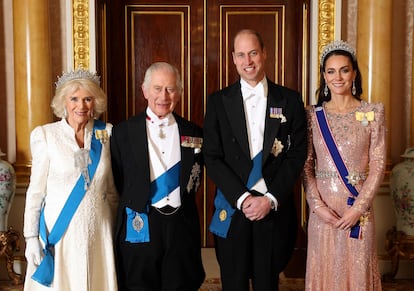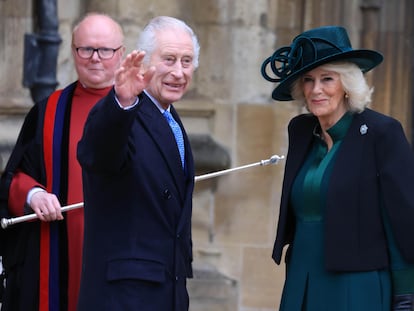King Charles and Prince William pocket millions in rent from schools, hospitals and military facilities
A media investigation finally reveals the source of the British royal family’s private fortune after decades demanding transparency

The British royal family has amassed one of the largest fortunes in the country. That is an undisputed fact. But the sources from which the Windsors generate millions in income each year have been largely opaque, obscured by complex financial structures and favorable tax deals agreed between the British state and Buckingham Palace.
Now, however, a thorough investigation by Channel 4 and The Sunday Times has finally managed to reveal the source of the annual fortune that both King Charles and his son and heir William earn through their real estate properties and the exploitation rights of their Duchies of Lancaster and Cornwall.
The King and Prince William pocketed profits of €60 million for their personal use generated from leasing land to public hospitals, schools, prisons, military facilities, ports and riverbanks for mooring and unloading, as well as land for electricity cables and pipes for fuel. It is an exorbitant sum in part due to a situation of fiscal privilege that exempts them from capital gains and corporate taxes, not to mention being completely shielded from hypothetical expropriations for public works.
Royal land for 10 centuries
Many tourists strolling through the upmarket Regent Street in central London are unaware that much of the land they walk on belongs to the British royal family or to some other aristocratic family that continues to obtain substantial profits from their real estate holdings.
The Crown handed over a large part of its possessions to the government almost three centuries ago. The British Treasury manages the Crown Estate, which consists of thousands of hectares of urban and rural land throughout the country. The Treasury gives a percentage of this income each year to the royal household to cover official expenses for state events, receptions, visits, public events and staff maintenance. The amount generated for 2025 will be around €157 million. This contrasts somewhat with European royal families’ official expenses which in the case of Spain amount to less than €8.5 million.
The British Parliament allowed the royal family to retain ownership and management of the Duchies of Lancaster and Cornwall. The first covers the private expenses of the monarch: those of Elizabeth II before her death and now those of King Charles; the Duchy of Cornwall covers the private expenses of the heir to the crown, the Prince of Wales. When this decision was taken, the income generated by their real estate was not excessive. In 1960, each of the Duchies would bring in around €6 million a year, a sum that has risen to close to €30 million.
Between them, they cover around 728 square kilometers, spread over England and Wales. They are lands conquered and retained by the different monarchs since the Norman conquest in 1066.
Over five months, The Sunday Times and Channel Four investigated public documents, checked business addresses and commercial registry data, and requested information from dozens of tenants or companies leasing land. The results were then put through a computer program that compiled details on the 5,410 real estate assets of the two Duchies.
The data, which Buckingham Palace has refused to release for decades, show a huge real estate fortune. According to the list of UK millionaires that The Sunday Times prepares every year, King Charles’ fortune stands at more than €720 million.
A hospital, a prison and at least four schools
No public institution escapes the financial tentacles of the Crown, according to the investigation. The Windsors generate income from real estate, charging either the central government, its various ministries, local authorities, non-governmental organizations and private companies: Tolls for crossing bridges, for navigating boats, for electricity cables or gas pipes, or the installation of wind farms.
Dartmoor prison pays the Crown about €1.8 million a year in rent to house 640 low-risk offenders. Guy’s and St Thomas’s Hospital in London pays the Windsors almost €1 million each year for the use of the land used to park their ambulances.
Devon pays the Duchy of Cornwall almost €380,000 each year for renting the land where Princetown Community Primary School is located. Other schools, such as Farrington Gurney in Bath (€71,000) or Welton Primary School (€4,500) also pay a yearly rent.
The British Ministry of Defense pays millions for the use of the Royal Navy Britannia School’s facilities in Dartmouth, where both King Charles and William were cadets (€1 million a year). A few miles away, on the same coast, the government pays €12,000 a year for the right to refuel the nuclear submarine fleet at Plymouth.
Both Charles and William voluntarily pay income tax at the maximum rate of 45%. They are not forthcoming, however, when it comes to providing data. The last details provided are from 2022 when the King paid €7 million; that is barely 25% of the income generated that year by the Duchy of Lancaster, after applying the legal deductions and exemptions.
Sign up for our weekly newsletter to get more English-language news coverage from EL PAÍS USA Edition
Tu suscripción se está usando en otro dispositivo
¿Quieres añadir otro usuario a tu suscripción?
Si continúas leyendo en este dispositivo, no se podrá leer en el otro.
FlechaTu suscripción se está usando en otro dispositivo y solo puedes acceder a EL PAÍS desde un dispositivo a la vez.
Si quieres compartir tu cuenta, cambia tu suscripción a la modalidad Premium, así podrás añadir otro usuario. Cada uno accederá con su propia cuenta de email, lo que os permitirá personalizar vuestra experiencia en EL PAÍS.
¿Tienes una suscripción de empresa? Accede aquí para contratar más cuentas.
En el caso de no saber quién está usando tu cuenta, te recomendamos cambiar tu contraseña aquí.
Si decides continuar compartiendo tu cuenta, este mensaje se mostrará en tu dispositivo y en el de la otra persona que está usando tu cuenta de forma indefinida, afectando a tu experiencia de lectura. Puedes consultar aquí los términos y condiciones de la suscripción digital.
More information
Archived In
Últimas noticias
Welcome to the post-religion era: The idea of Christianity as the absolute truth has become obsolete
‘I thought you would like it’: The risky sexual practice popularized by TV shows and TikTok
The digitalization of tourism: ‘They promise experiences and gave us the worst possible one’
Mexican peso defies uncertainty with forecasts of a new period of stability in 2026
Most viewed
- Sinaloa Cartel war is taking its toll on Los Chapitos
- Oona Chaplin: ‘I told James Cameron that I was living in a treehouse and starting a permaculture project with a friend’
- Reinhard Genzel, Nobel laureate in physics: ‘One-minute videos will never give you the truth’
- Why the price of coffee has skyrocketed: from Brazilian plantations to specialty coffee houses
- Silver prices are going crazy: This is what’s fueling the rally











































